

Life Is Beautiful Nazi death camp survivor dies aged 91. He arrived at Auschwitz at the age of 24.
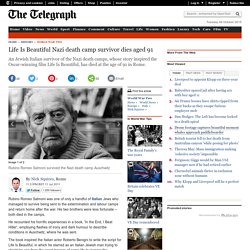
"At Auschwitz I was no longer Rubino Romeo Salmoni, but Jew number A15810, to be exterminated," he later wrote. Put to work as a forced labourer, he managed to survive until the camp was liberated by the Allies in 1945. In the decades after the war, he retold his story many times, often during visits to schools and colleges, determined that the Holocaust should not be forgotten. He described life in the concentration camp as "hellish", a constant struggle against hunger, cold and exhaustion in which inmates were treated savagely by the guards.
Morning roll calls by the camp commandant could last for hours as prisoners shivered barefoot in the snow, he recalled. He saw his survival as a triumph against Nazism. Concentration camps in Nazi Germany. Concentration camps in Nazi Germany served a number of purposes.

First, these camps were used to jail those who opposed Hitler’s government or were thought to threaten it. Second, knowledge of what life was like in a concentration camp was allowed to leak out – or came out when someone was released. The fear of ending up in such a camp was sufficient for a great many Germans to openly declare their loyalty to Hitler even if this was not the case. Concentration Camps -The Holocaust Explained. Hitler was appointed Chancellor on 30 January 1933.
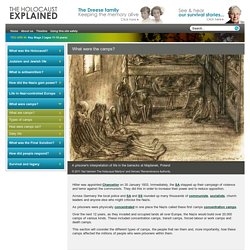
Immediately, the SA stepped up their campaign of violence and terror against the communists. They did this in order to increase their power and to reduce opposition. Across Germany the local police and SA and SS rounded up many thousands of communists, socialists, church leaders and anyone else who might criticise the Nazis. As prisoners were physically concentrated in one place the Nazis called these first camps concentration camps. Communism vs Fascism. What are Communism and Fascism?
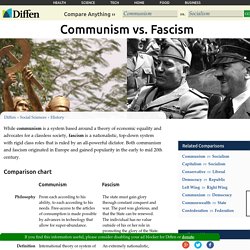
As a socioeconomic system, communism considers all property to be communal — that is, owned by the community or by the state. This system also stresses the importance of a "classless" society, where there are no differences between the wealthy and the working classes, between men and women, or between races. While Marxist communism is the most common form of communism, there is also non-Marxist communism. Fascism is also a political and economic system, but its focus is on the nation state, as ruled by a dictator, and on rigid social structure. Under fascism, hyper-masculinity, youth, and even violence and militarism are held in high regard.
Communist Philosophy Communism can be traced back to Thomas More, a prominent English Catholic who wrote about a society based around common ownership of property in Utopia in 1516. Benito Mussolini. Biography >> World War 2 for Kids Occupation: Dictator of Italy Born: July 29, 1883 in Predappio, Italy Died: April 28, 1945 in Giulino di Mezzegra, Italy Best known for: Ruling Italy during World War II and founding the Fascist Party Biography: Where did Mussolini grow up?
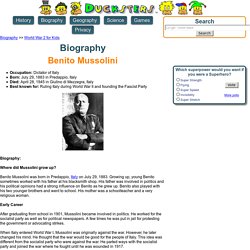
Benito Mussolini was born in Predappio, Italy on July 29, 1883. Growing up, young Benito sometimes worked with his father at his blacksmith shop. His father was involved in politics and his political opinions had a strong influence on Benito as he grew up. Early Career. Life in Fascist Italy. Life in Mussolini’s Italy was little different from other dictatorships which existed between 1918 and 1939.Nazi Germany and Stalin’s Russia were to use (and expand) on developments that had been in existence in Fascist Italy since the 1920’s.
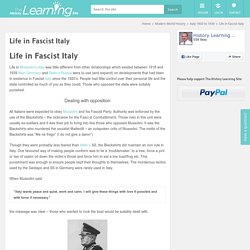
People had little control over their personal life and the state controlled as much of you as they could. Those who opposed the state were suitably punished. Dealing with opposition All Italians were expected to obey Mussolini and his Fascist Party. Authority was enforced by the use of the Blackshirts – the nickname for the Fasci di Combattimenti. Though they were probably less feared than Hitler’s SS, the Blackshirts did maintain an iron rule in Italy. When Mussolini said: the message was clear – those who wanted to rock the boat would be suitably dealt with. Fascism in WW2 Italy. Modern History Sourcebook: Benito Mussolini: What is Fascism, 1932 Benito Mussolini (1883-1945) over the course of his lifetime went from Socialism - he was editor of Avanti, a socialist newspaper - to the leadership of a new political movement called "fascism" [after "fasces", the symbol of bound sticks used a totem of power in ancient Rome].
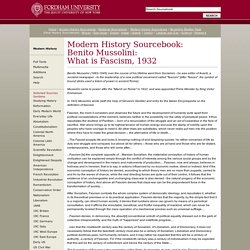
Mussolini came to power after the "March on Rome" in 1922, and was appointed Prime Minister by King Victor Emmanuel. The Destruction of the Italian Jews The German Occupation of Europe. Jews in Italy under Fascist and Nazi rule, 1922-1945. Cambridge University Press 0521841011 - Jews in Italy under Fascist and Nazi rule, 1922-1945 - Edited by Joshua D.
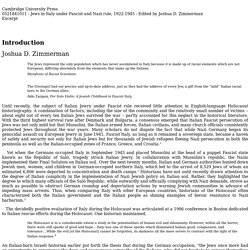
Zimmerman Excerpt Introduction Joshua D. Zimmerman Until recently, the subject of Italian Jewry under Fascist rule received little attention in English-language Holocaust historiography. Italy during WW2. BACKGROUND In October 1922, King Victor Emmanuel III appointed the leader of the Italian Fascist Party, Benito Mussolini, as prime minister of Italy.

Over the next seven years, the Fascists established and consolidated a one-party dictatorship. In two ways, Mussolini failed to establish an absolute dictatorship, however.